ISUZU TROOPER 1998 Service Repair Manual
Manufacturer: ISUZU, Model Year: 1998, Model line: TROOPER, Model: ISUZU TROOPER 1998Pages: 3573, PDF Size: 60.36 MB
Page 141 of 3573
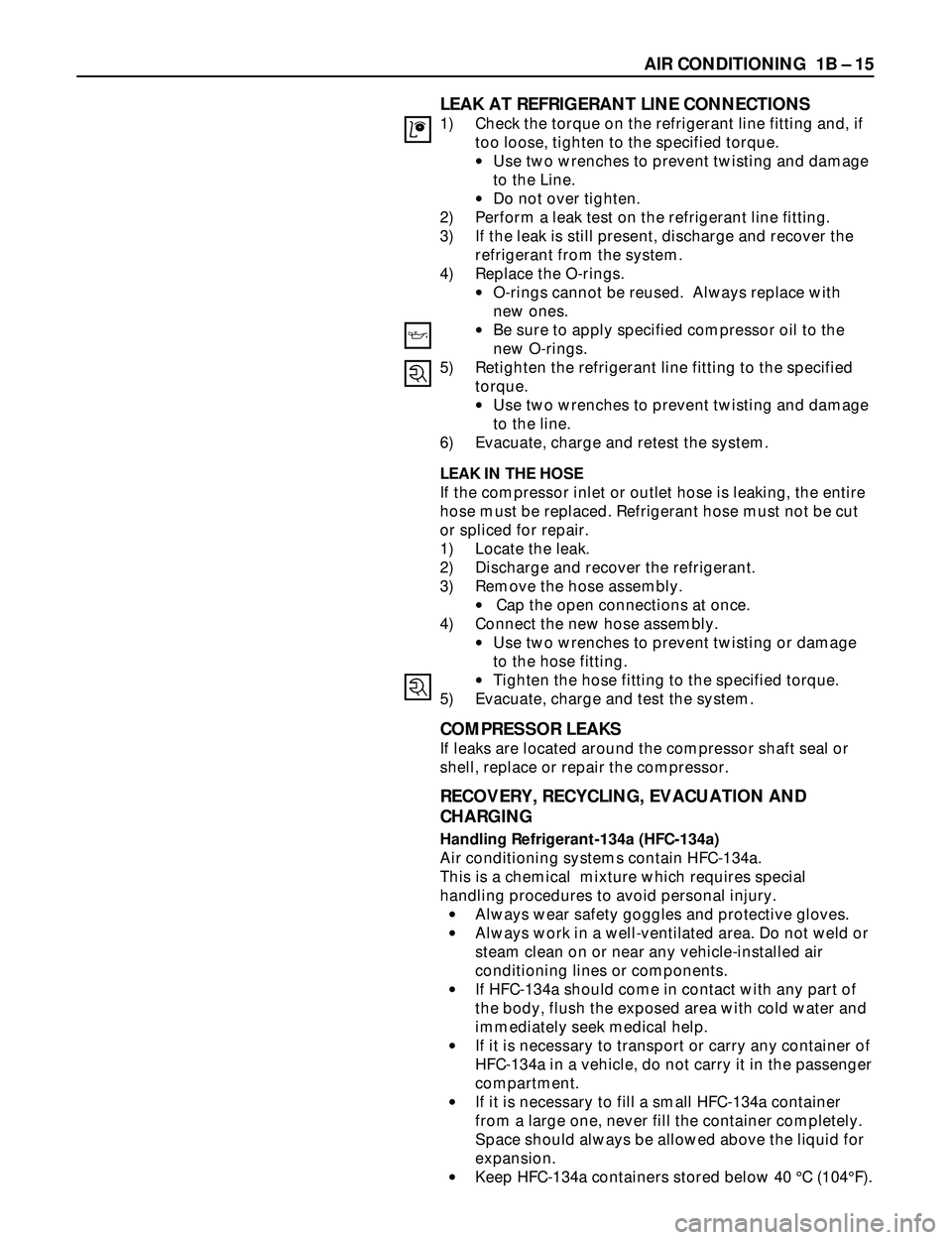
AIR CONDITIONING 1B Ð 15
COMPRESSOR LEAKS
If leaks are located around the compressor shaft seal or
shell, replace or repair the compressor.
RECOVERY, RECYCLING, EVACUATION AND
CHARGING
Handling Refrigerant-134a (HFC-134a)
Air conditioning systems contain HFC-134a.
This is a chemical mixture which requires special
handling procedures to avoid personal injury.
·Always wear safety goggles and protective gloves.
·Always work in a well-ventilated area. Do not weld or
steam clean on or near any vehicle-installed air
conditioning lines or components.
·If HFC-134a should come in contact with any part of
the body, flush the exposed area with cold water and
immediately seek medical help.
·If it is necessary to transport or carry any container of
HFC-134a in a vehicle, do not carry it in the passenger
compartment.
·If it is necessary to fill a small HFC-134a container
from a large one, never fill the container completely.
Space should always be allowed above the liquid for
expansion.
·Keep HFC-134a containers stored below 40 ¡C (104¡F).
LEAK AT REFRIGERANT LINE CONNECTIONS
1) Check the torque on the refrigerant line fitting and, if
too loose, tighten to the specified torque.
·Use two wrenches to prevent twisting and damage
to the Line.
·Do not over tighten.
2) Perform a leak test on the refrigerant line fitting.
3) If the leak is still present, discharge and recover the
refrigerant from the system.
4) Replace the O-rings.
·O-rings cannot be reused. Always replace with
new ones.
·Be sure to apply specified compressor oil to the
new O-rings.
5) Retighten the refrigerant line fitting to the specified
torque.
·Use two wrenches to prevent twisting and damage
to the line.
6) Evacuate, charge and retest the system.
LEAK IN THE HOSE
If the compressor inlet or outlet hose is leaking, the entire
hose must be replaced. Refrigerant hose must not be cut
or spliced for repair.
1) Locate the leak.
2) Discharge and recover the refrigerant.
3) Remove the hose assembly.
·Cap the open connections at once.
4) Connect the new hose assembly.
·Use two wrenches to prevent twisting or damage
to the hose fitting.
·Tighten the hose fitting to the specified torque.
5) Evacuate, charge and test the system.
Page 142 of 3573
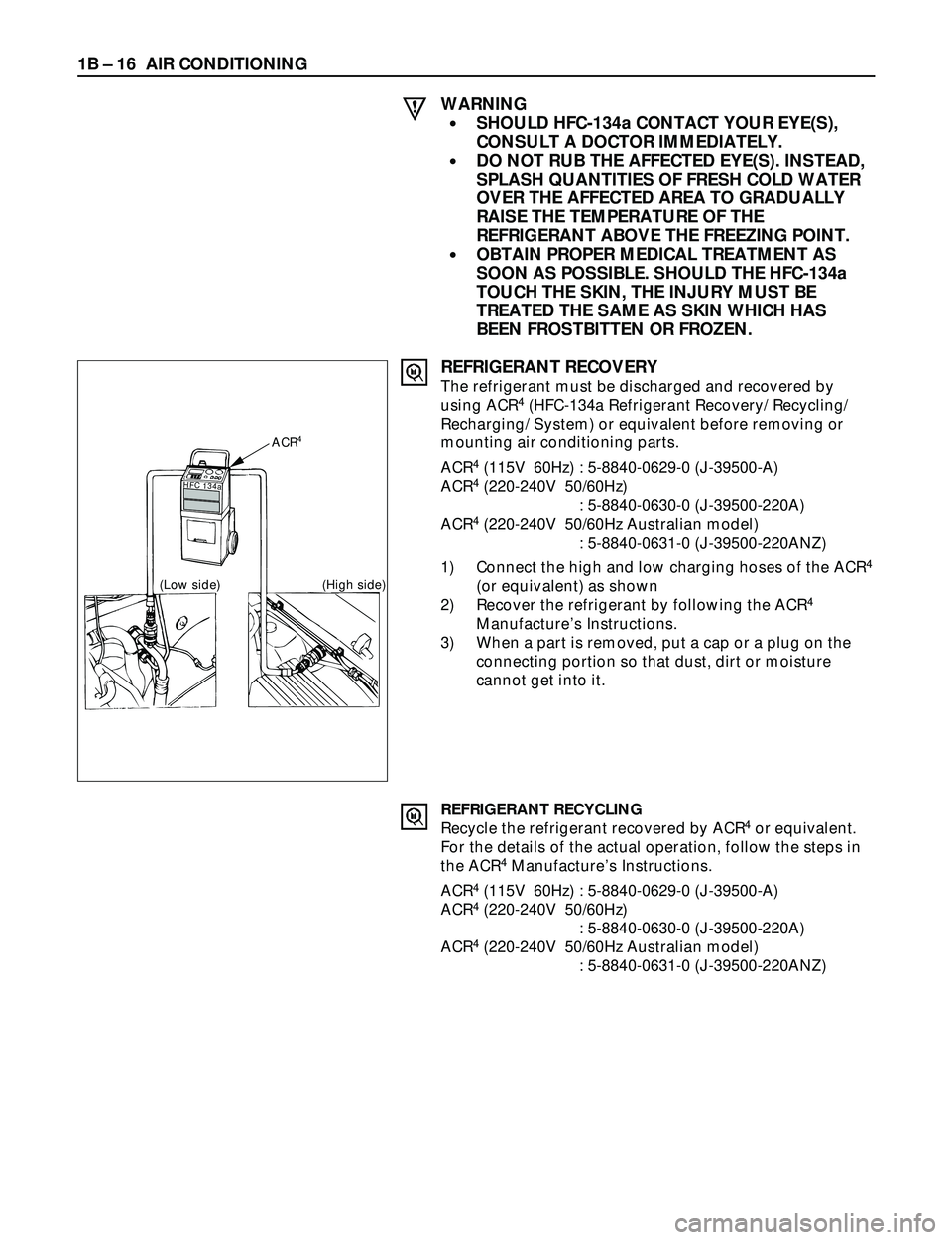
1B Ð 16 AIR CONDITIONING
WARNING
·SHOULD HFC-134a CONTACT YOUR EYE(S),
CONSULT A DOCTOR IMMEDIATELY.
·DO NOT RUB THE AFFECTED EYE(S). INSTEAD,
SPLASH QUANTITIES OF FRESH COLD WATER
OVER THE AFFECTED AREA TO GRADUALLY
RAISE THE TEMPERATURE OF THE
REFRIGERANT ABOVE THE FREEZING POINT.
·OBTAIN PROPER MEDICAL TREATMENT AS
SOON AS POSSIBLE. SHOULD THE HFC-134a
TOUCH THE SKIN, THE INJURY MUST BE
TREATED THE SAME AS SKIN WHICH HAS
BEEN FROSTBITTEN OR FROZEN.
REFRIGERANT RECOVERY
The refrigerant must be discharged and recovered by
using ACR4(HFC-134a Refrigerant Recovery/ Recycling/
Recharging/ System) or equivalent before removing or
mounting air conditioning parts.
ACR
4(115V 60Hz) : 5-8840-0629-0 (J-39500-A)
ACR4(220-240V 50/60Hz)
: 5-8840-0630-0 (J-39500-220A)
ACR
4(220-240V 50/60Hz Australian model)
: 5-8840-0631-0 (J-39500-220ANZ)
1) Connect the high and low charging hoses of the ACR
4
(or equivalent) as shown
2) Recover the refrigerant by following the ACR4
ManufactureÕs Instructions.
3) When a part is removed, put a cap or a plug on the
connecting portion so that dust, dirt or moisture
cannot get into it.
ACR4
(Low side) (High side)
HFC 134a
REFRIGERANT RECYCLING
Recycle the refrigerant recovered by ACR4or equivalent.
For the details of the actual operation, follow the steps in
the ACR
4ManufactureÕs Instructions.
ACR
4(115V 60Hz) : 5-8840-0629-0 (J-39500-A)
ACR4(220-240V 50/60Hz)
: 5-8840-0630-0 (J-39500-220A)
ACR
4(220-240V 50/60Hz Australian model)
: 5-8840-0631-0 (J-39500-220ANZ)
Page 143 of 3573
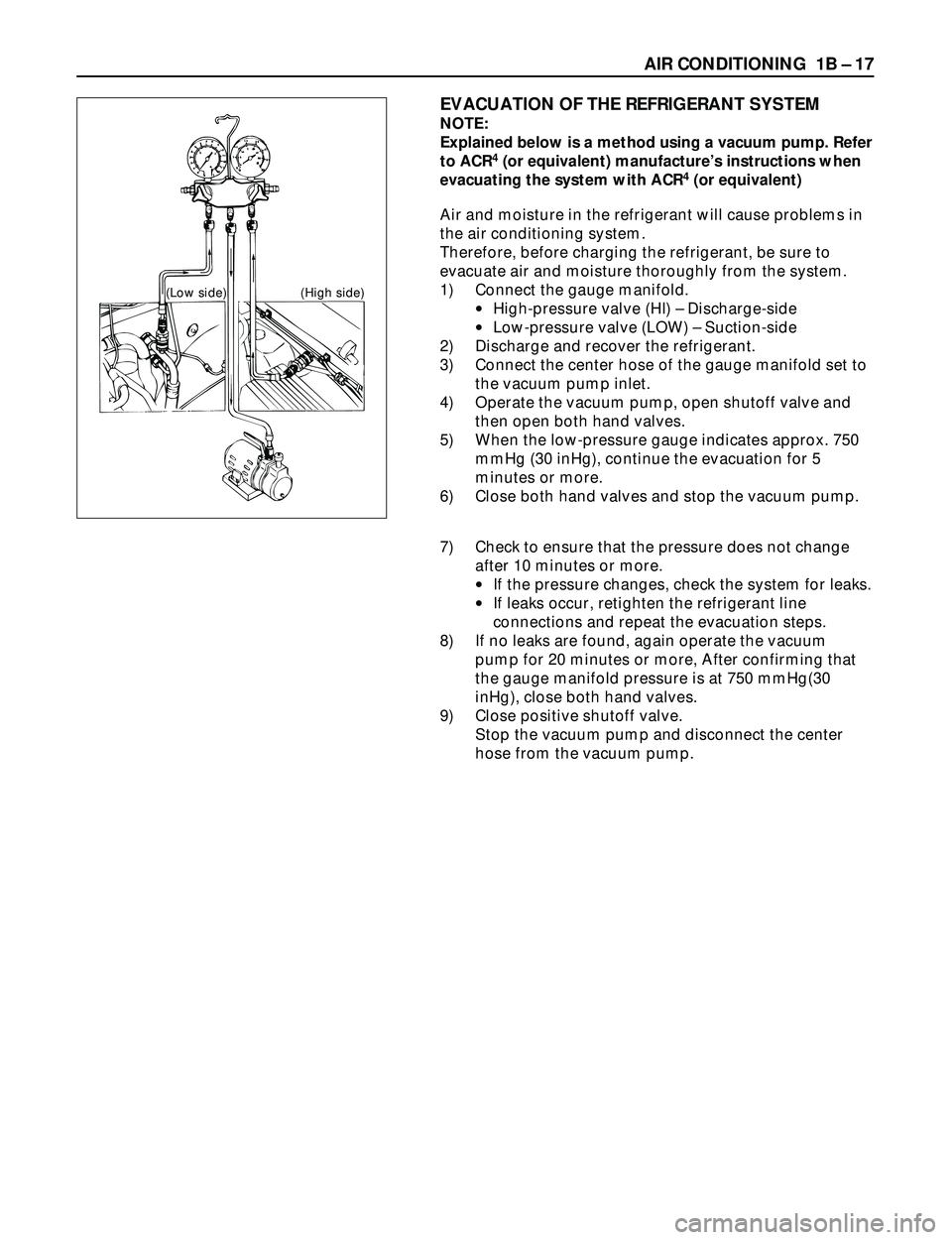
AIR CONDITIONING 1B Ð 17
7) Check to ensure that the pressure does not change
after 10 minutes or more.
·If the pressure changes, check the system for leaks.
·If leaks occur, retighten the refrigerant line
connections and repeat the evacuation steps.
8) If no leaks are found, again operate the vacuum
pump for 20 minutes or more, After confirming that
the gauge manifold pressure is at 750 mmHg(30
inHg), close both hand valves.
9) Close positive shutoff valve.
Stop the vacuum pump and disconnect the center
hose from the vacuum pump. Air and moisture in the refrigerant will cause problems in
the air conditioning system.
Therefore, before charging the refrigerant, be sure to
evacuate air and moisture thoroughly from the system.
1) Connect the gauge manifold.
·High-pressure valve (HI) Ð Discharge-side
·Low-pressure valve (LOW) Ð Suction-side
2) Discharge and recover the refrigerant.
3) Connect the center hose of the gauge manifold set to
the vacuum pump inlet.
4) Operate the vacuum pump, open shutoff valve and
then open both hand valves.
5) When the low-pressure gauge indicates approx. 750
mmHg (30 inHg), continue the evacuation for 5
minutes or more.
6) Close both hand valves and stop the vacuum pump.
EVACUATION OF THE REFRIGERANT SYSTEM
NOTE:
Explained below is a method using a vacuum pump. Refer
to ACR
4(or equivalent) manufactureÕs instructions when
evacuating the system with ACR4(or equivalent)
(Low side) (High side)
Page 144 of 3573
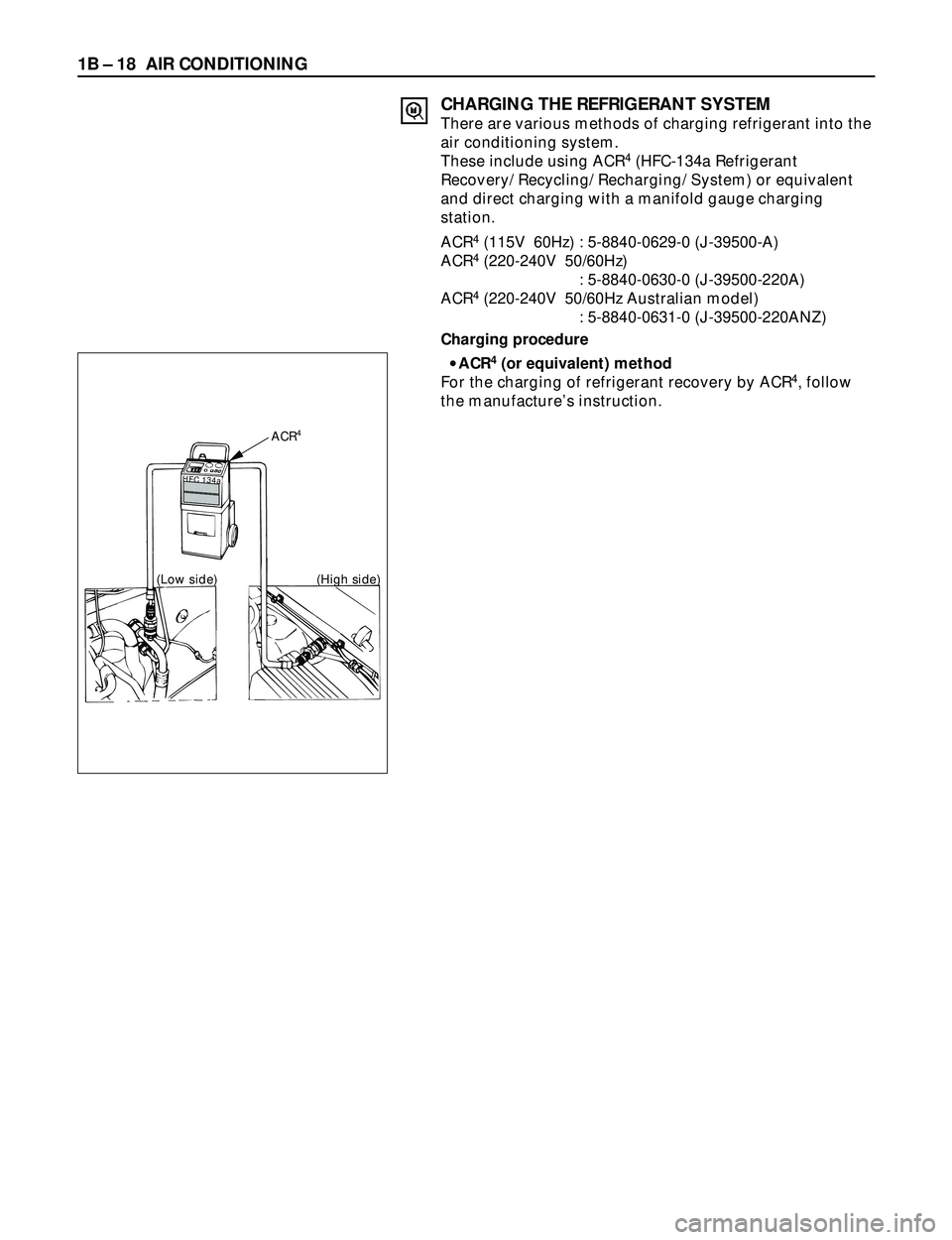
1B Ð 18 AIR CONDITIONING
CHARGING THE REFRIGERANT SYSTEM
There are various methods of charging refrigerant into the
air conditioning system.
These include using ACR
4(HFC-134a Refrigerant
Recovery/ Recycling/ Recharging/ System) or equivalent
and direct charging with a manifold gauge charging
station.
ACR
4(115V 60Hz) : 5-8840-0629-0 (J-39500-A)
ACR4(220-240V 50/60Hz)
: 5-8840-0630-0 (J-39500-220A)
ACR
4(220-240V 50/60Hz Australian model)
: 5-8840-0631-0 (J-39500-220ANZ)
Charging procedure
·ACR4(or equivalent) method
For the charging of refrigerant recovery by ACR4, follow
the manufactureÕs instruction.
ACR4
(Low side) (High side)
HFC 134a
Page 145 of 3573
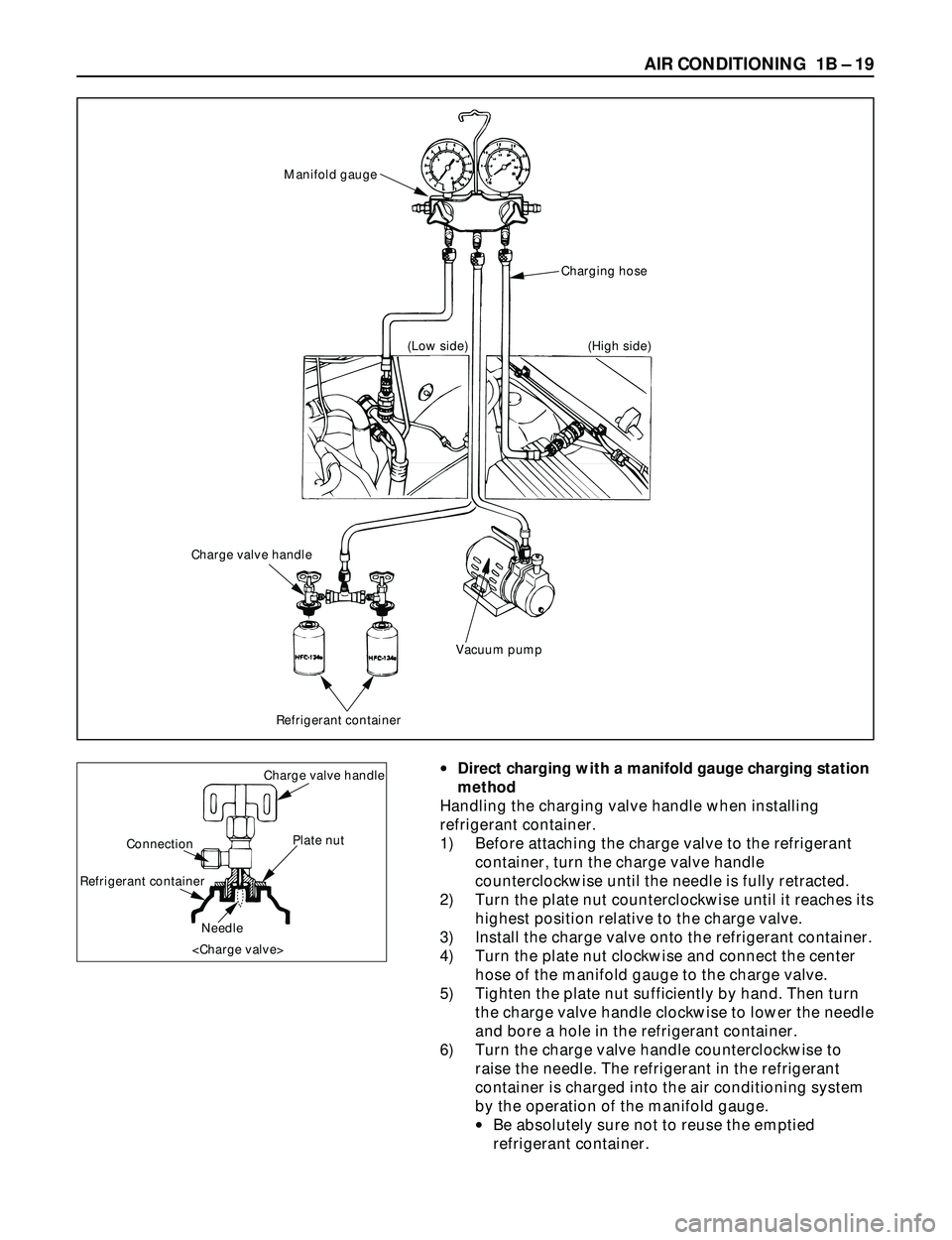
AIR CONDITIONING 1B Ð 19
·Direct charging with a manifold gauge charging station
method
Handling the charging valve handle when installing
refrigerant container.
1) Before attaching the charge valve to the refrigerant
container, turn the charge valve handle
counterclockwise until the needle is fully retracted.
2) Turn the plate nut counterclockwise until it reaches its
highest position relative to the charge valve.
3) Install the charge valve onto the refrigerant container.
4) Turn the plate nut clockwise and connect the center
hose of the manifold gauge to the charge valve.
5) Tighten the plate nut sufficiently by hand. Then turn
the charge valve handle clockwise to lower the needle
and bore a hole in the refrigerant container.
6) Turn the charge valve handle counterclockwise to
raise the needle. The refrigerant in the refrigerant
container is charged into the air conditioning system
by the operation of the manifold gauge.
·Be absolutely sure not to reuse the emptied
refrigerant container.Charge valve handle
Plate nut
Needle Connection
Refrigerant container
Charging hose Manifold gauge
Vacuum pump
Refrigerant container
Charge valve handle
(Low side) (High side)
Page 146 of 3573
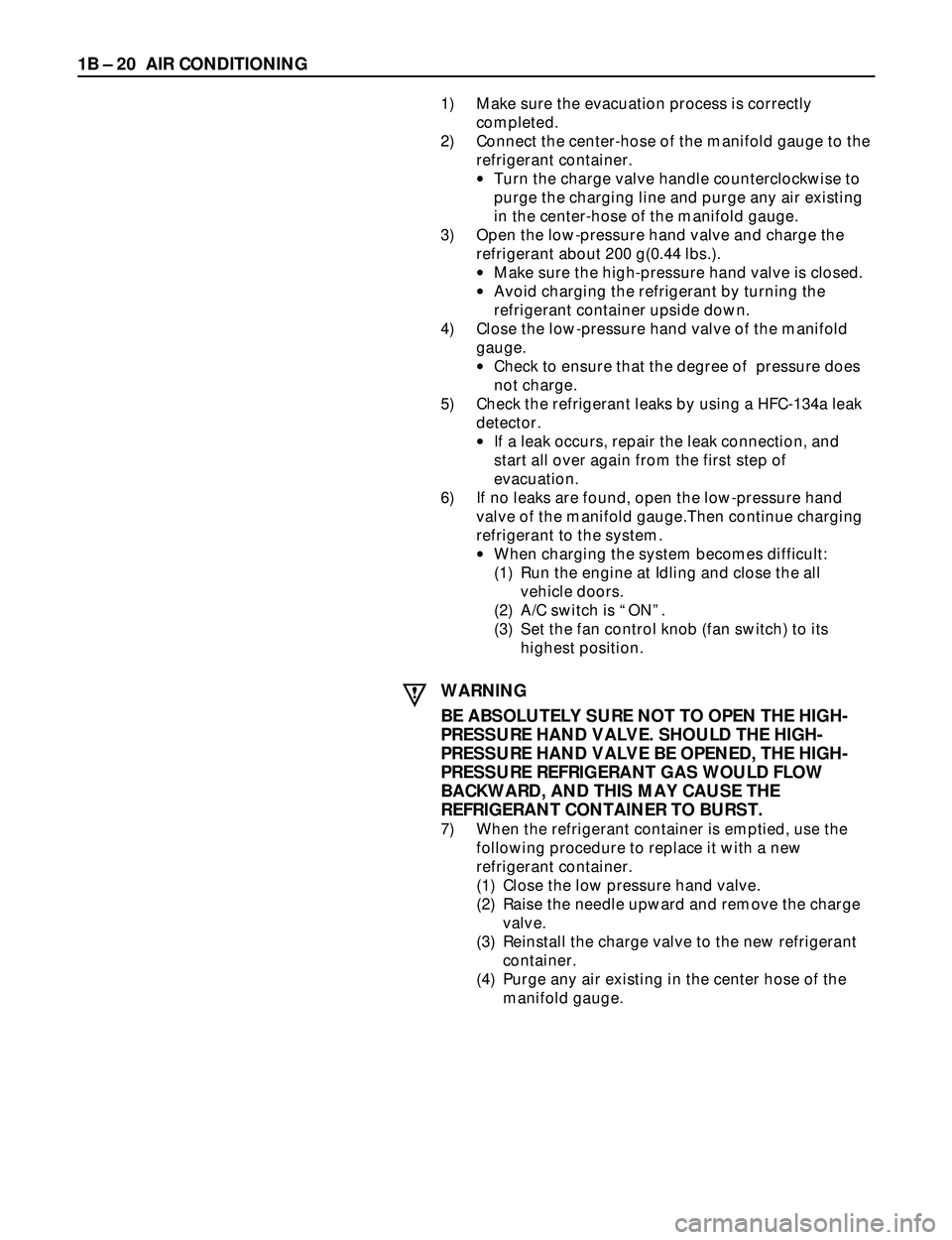
1B Ð 20 AIR CONDITIONING
1) Make sure the evacuation process is correctly
completed.
2) Connect the center-hose of the manifold gauge to the
refrigerant container.
·Turn the charge valve handle counterclockwise to
purge the charging line and purge any air existing
in the center-hose of the manifold gauge.
3) Open the low-pressure hand valve and charge the
refrigerant about 200 g(0.44 lbs.).
·Make sure the high-pressure hand valve is closed.
·Avoid charging the refrigerant by turning the
refrigerant container upside down.
4) Close the low-pressure hand valve of the manifold
gauge.
·Check to ensure that the degree of pressure does
not charge.
5) Check the refrigerant leaks by using a HFC-134a leak
detector.
·If a leak occurs, repair the leak connection, and
start all over again from the first step of
evacuation.
6) If no leaks are found, open the low-pressure hand
valve of the manifold gauge.Then continue charging
refrigerant to the system.
·When charging the system becomes difficult:
(1) Run the engine at Idling and close the all
vehicle doors.
(2) A/C switch is ÒONÓ.
(3) Set the fan control knob (fan switch) to its
highest position.
WARNING
BE ABSOLUTELY SURE NOT TO OPEN THE HIGH-
PRESSURE HAND VALVE. SHOULD THE HIGH-
PRESSURE HAND VALVE BE OPENED, THE HIGH-
PRESSURE REFRIGERANT GAS WOULD FLOW
BACKWARD, AND THIS MAY CAUSE THE
REFRIGERANT CONTAINER TO BURST.
7) When the refrigerant container is emptied, use the
following procedure to replace it with a new
refrigerant container.
(1) Close the low pressure hand valve.
(2) Raise the needle upward and remove the charge
valve.
(3) Reinstall the charge valve to the new refrigerant
container.
(4) Purge any air existing in the center hose of the
manifold gauge.
Page 147 of 3573
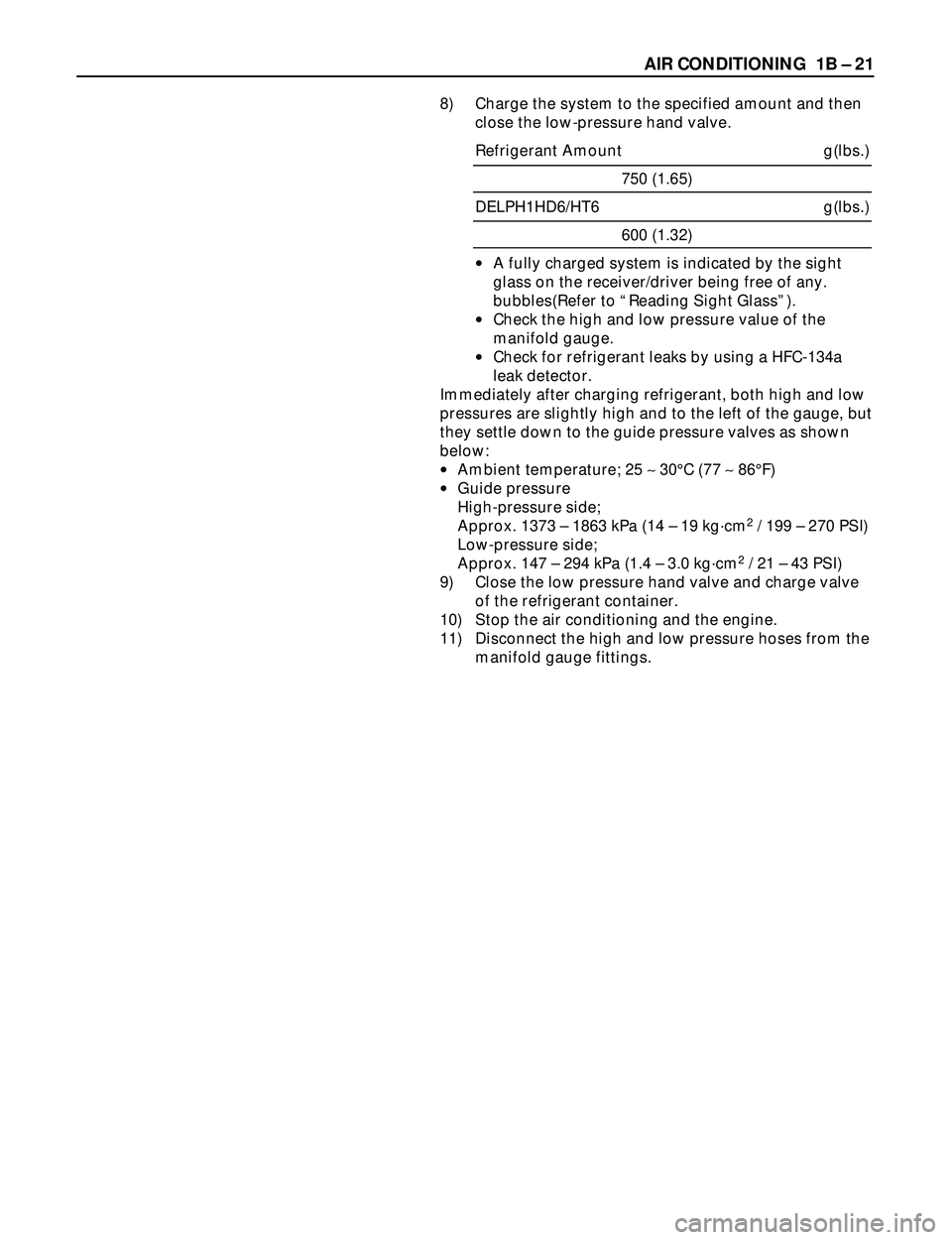
AIR CONDITIONING 1B Ð 21
8) Charge the system to the specified amount and then
close the low-pressure hand valve.
Refrigerant Amount g(lbs.)
750 (1.65)
DELPH1HD6/HT6 g(lbs.)
600 (1.32)
·A fully charged system is indicated by the sight
glass on the receiver/driver being free of any.
bubbles(Refer to ÒReading Sight GlassÓ).
·Check the high and low pressure value of the
manifold gauge.
·Check for refrigerant leaks by using a HFC-134a
leak detector.
Immediately after charging refrigerant, both high and low
pressures are slightly high and to the left of the gauge, but
they settle down to the guide pressure valves as shown
below:
·Ambient temperature; 25 ~30¡C (77 ~86¡F)
·Guide pressure
High-pressure side;
Approx. 1373 Ð 1863 kPa (14 Ð 19 kgácm
2/ 199 Ð 270 PSI)
Low-pressure side;
Approx. 147 Ð 294 kPa (1.4 Ð 3.0 kgácm
2/ 21 Ð 43 PSI)
9) Close the low pressure hand valve and charge valve
of the refrigerant container.
10) Stop the air conditioning and the engine.
11) Disconnect the high and low pressure hoses from the
manifold gauge fittings.
Page 148 of 3573

1B Ð 22 AIR CONDITIONING
Almost transparent.
A flow of bubbles
can be seen, but
they disappear
when the throttle is
opened.
The sight glass provides accurate diagnosis only under the following conditions.
If the vehicle can be tested under these conditions, check the sight glass appearance and compare to the
chart.
* Engine speed Idling
* A/C switch ÒONÓ
* Blower fan operating at highest speed
* Air source selector lever at ÒRECIRCÓ
* Temperature control knob at coldest position
* Ambient temperature below 30¡C (86¡F) and humidity below 70% (See NOTE 1)
* High side pressure less than 1863 kPa (19 kgácm
2/ 270 PSI) (See NOTE 2)
NOTE 1
If the vehicle cannot be moved to a testing location that meets these specifications, then the sight glass
cannot be used for diagnosis. You must discharge and recover the refrigerant, then recharge the system
with the specified amount of refrigerant. Then continue checking the system performance.
NOTE 2
If the high side pressure is greater than stated, the sight glass cannot be used for diagnosis. You must
discharge and recover the refrigerant, then recharge the system with the specified amount of refrigerant.
Then continue checking system performance.
Reading Sight Glass
High and low
pressure pipe
temperature
Sight glass
condition
Air condi-
tioner cycle
condition
The high pressure
pipe is hot and the
low pressure pipe is
cold. There is a dis-
tinct difference in
temperature bet-
ween them.
OK
The high pressure
pipe is warm and
the low pressure
pipe is cool. There
is no great dif-
ference in tempera-
ture between them.
A flow of bubbles
always can be seen.
It appears some-
times transparent,
and sometimes
frothy.
NG
(Not enough
refrigerant)
There is little dif-
ference in tempera-
ture between the
high pressure pipe
and the low press-
ure pipe.
Something like fog
faintly can be seen.
NG
(Almost no
refrigerant)
The high pressure
pipe is hot and the
low pressure pipe is
slightly warm.
There is a difference
in temperature bet-
ween them.
Even at idle with the
fan at ÒHIÓ (with the
window fully open),
the bubbles cannot
be seen.
NG
(Too much
refrigerant)
Page 149 of 3573
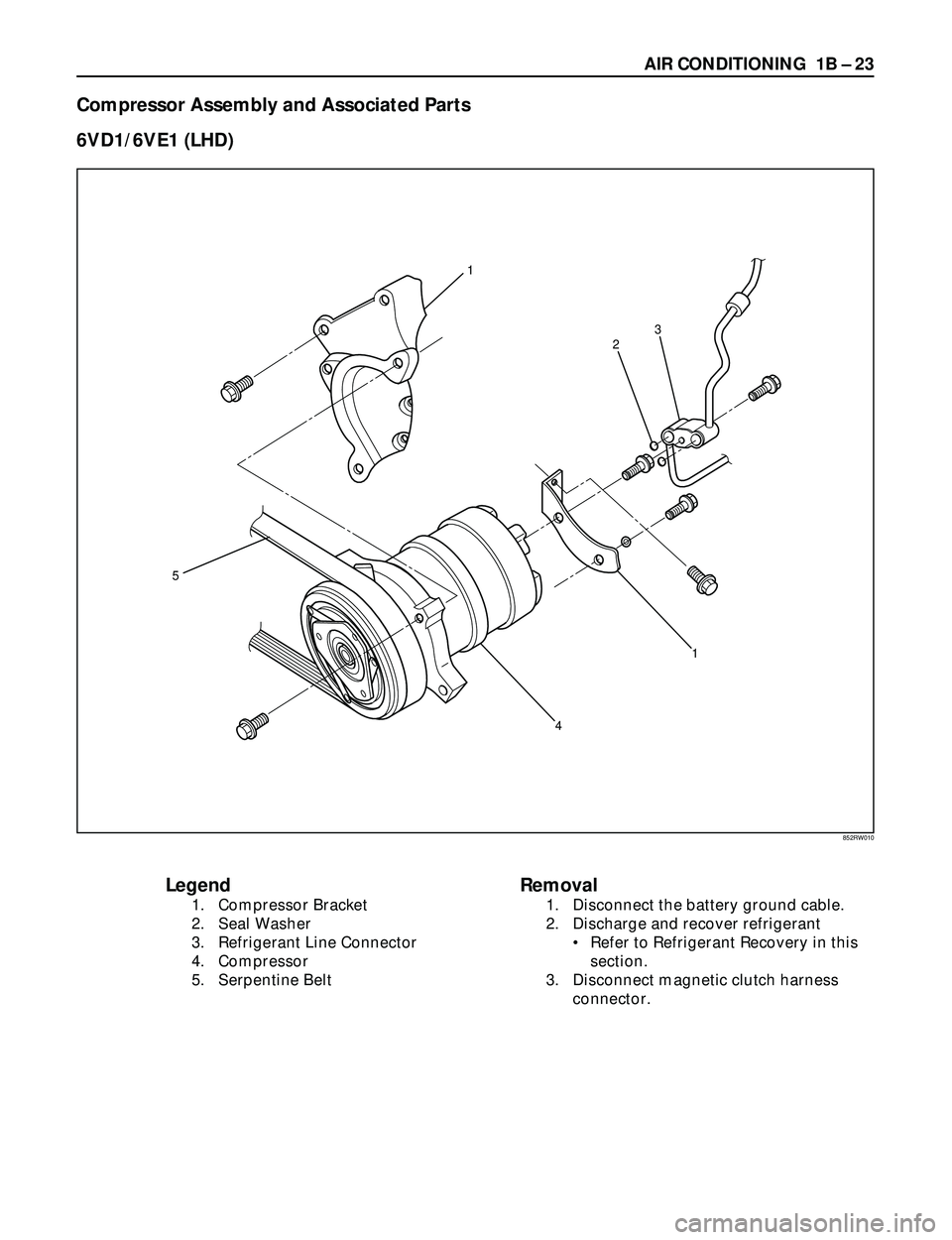
AIR CONDITIONING 1B Ð 23
Legend
1. Compressor Bracket
2. Seal Washer
3. Refrigerant Line Connector
4. Compressor
5. Serpentine Belt
Removal
1. Disconnect the battery ground cable.
2. Discharge and recover refrigerant
¥ Refer to Refrigerant Recovery in this
section.
3. Disconnect magnetic clutch harness
connector.
Compressor Assembly and Associated Parts
6VD1/6VE1 (LHD)
1
5
23
4
1
852RW010
Page 150 of 3573
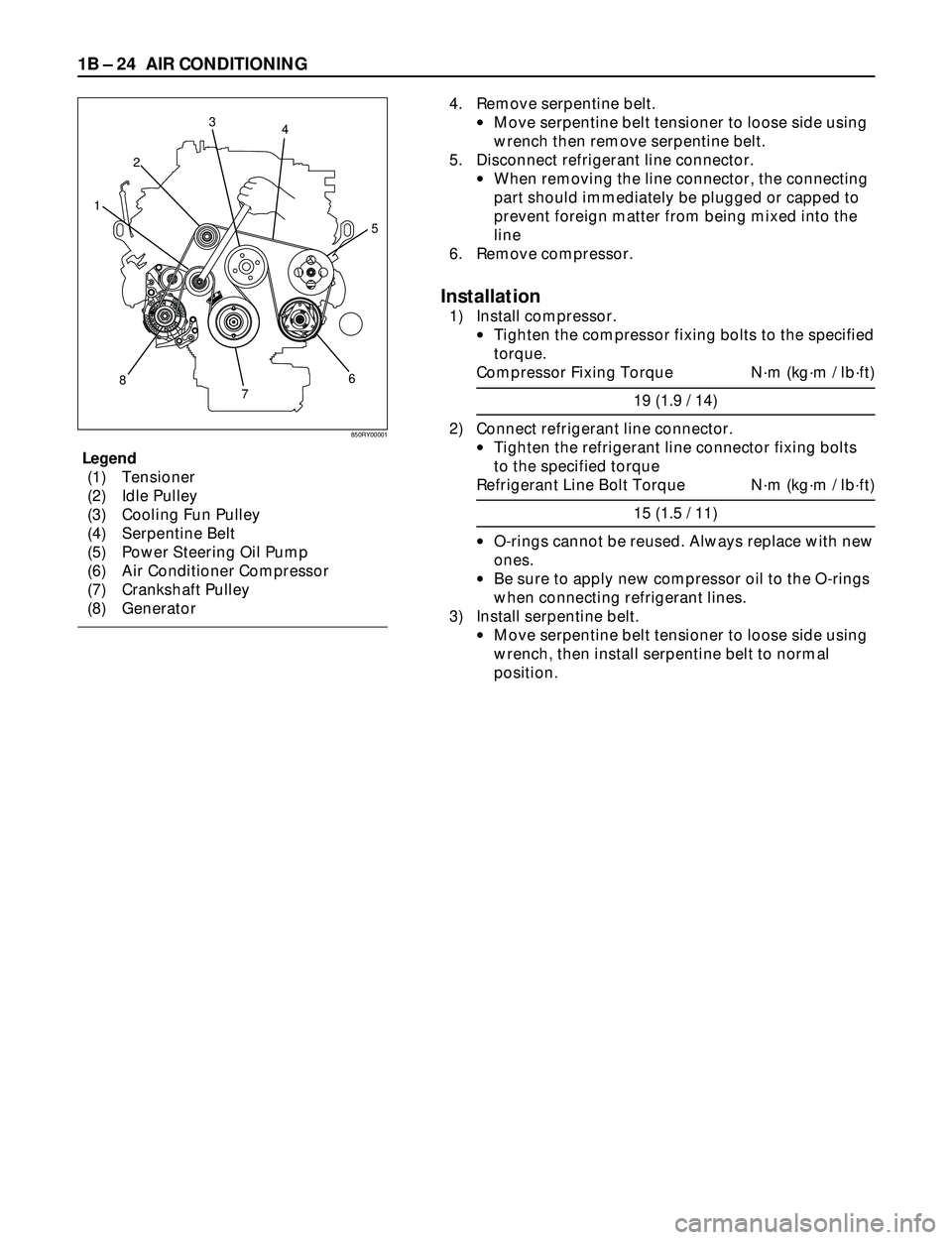
1B Ð 24 AIR CONDITIONING
3
4
2
7 86 1
5
4. Remove serpentine belt.
·Move serpentine belt tensioner to loose side using
wrench then remove serpentine belt.
5. Disconnect refrigerant line connector.
·When removing the line connector, the connecting
part should immediately be plugged or capped to
prevent foreign matter from being mixed into the
line
6. Remove compressor.
Installation
1) Install compressor.
·Tighten the compressor fixing bolts to the specified
torque.
Compressor Fixing Torque Nám (kgám / lbáft)
19 (1.9 / 14)
2) Connect refrigerant line connector.
·Tighten the refrigerant line connector fixing bolts
to the specified torque
Refrigerant Line Bolt Torque Nám (kgám / lbáft)
15 (1.5 / 11)
·O-rings cannot be reused. Always replace with new
ones.
·Be sure to apply new compressor oil to the O-rings
when connecting refrigerant lines.
3) Install serpentine belt.
·Move serpentine belt tensioner to loose side using
wrench, then install serpentine belt to normal
position.
850RY00001
Legend
(1) Tensioner
(2) Idle Pulley
(3) Cooling Fun Pulley
(4) Serpentine Belt
(5) Power Steering Oil Pump
(6) Air Conditioner Compressor
(7) Crankshaft Pulley
(8) Generator